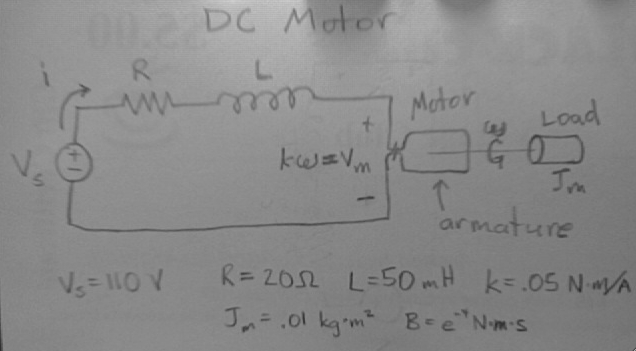Laplace transforms:DC Motor circuit: Difference between revisions
| Line 78: | Line 78: | ||
The transfer function of the motor voltage over the voltage source. |
The transfer function of the motor voltage over the voltage source. |
||
<math>H(s) = |
<math>H(s) = \frac{V_m(s)}{V_s(s)} = \frac{\Omega(s)}{k}</math> |
||
---- |
---- |
||
Reviewed by Andrew Hellie |
Reviewed by Andrew Hellie |
||
Revision as of 10:59, 28 October 2009
Problem
Find the steady state current i(t) through a DC motor represented by a series R-L-Motor circuit. The resistance (R) is from the armature winding. The inductance (L) is the equivalent inductance of the wire coil (which turns by current flowing through the coil in a permanent magnetic field). Jm is the combined moment of inertia of the armature and load. B is the coefficient of friction. The motor has input current i(t) and output angular velocity ω(t). Let v(t) = 110u(t)V, R = 20Ω, L = 50mH, k = 0.05N*m/A, Jm = 0.01 kg*m2, and B = e-4N*m*s.
Solution
Since some of the elements of a motor are not typical circuit elements, we must solve this problem using Laplace transforms.
The torque is proportional to the armature current.
Similarly, relating mechanical (T(t)ω(t)) and electrical (vm(t)i(t)) power, the conservation of energy requires the same proportionality between the voltage across the motor (vm(t)) and the angular velocity (ω(t)).
We want to find the Laplace transfer function of the motor, and we define it as follows.
Summing the voltages around the series circuit gives us our differential equation.
Take the Laplace transform.
If we let i(0) equal zero, the transformed differential equation gives us Equation *1*.
Repeat the process with the analogous mechanical differential equation. Here Jm is the moment of inertia of the combined armature, shaft, and load. B is the coefficient of friction.
Transforming yields the following.
Recall T(t) = k i(t), and so T(s) = k I(s). Again let ω(0) = 0. This gives us Equation *2*.
Solve Equation *2* for I(s) and substitute that into Equation *1*.
Solve this equation for Ω(s), some simplification steps are skipped here. Equation *3*
Now in order to apply the final value theorem we let Vs(s) = K/s. The s's in the limit definition and in K/s cancel. We can now see ω in steady state.
Take Equation *2* and Equation *3* and this time solve for I(s). This will get us a form of the final answer in the s domain.
Finally was can apply the final value theorem to see what our steady state response will be for the armature current.
Answers
Of interest are the ω(∞) and i(∞), found by plugging values into the steady state solutions above.
Bode Plot
Break Points and Asymptotes
The transfer function of the motor voltage over the voltage source.
Reviewed by Andrew Hellie



![{\displaystyle \Omega (s)={\mathcal {L}}[\omega (t)]/v_{s}(s)}](https://wikimedia.org/api/rest_v1/media/math/render/svg/636ab7f754f600f7c51b29ff144cfebb09a2c13f)









![{\displaystyle I(s)={\frac {(J_{m}s+B)}{k}}\left[{\frac {\frac {k}{J_{m}L}}{s(s^{2}+({\frac {B}{J_{m}}}+{\frac {R}{L}})s+{\frac {RB+k^{2}}{J_{m}L}})}}\right]K={\frac {{\frac {s}{L}}+{\frac {B}{J_{m}L}}}{s(s^{2}+({\frac {B}{J_{m}}}+{\frac {R}{L}})s+{\frac {RB+k^{2}}{J_{m}L}})}}K}](https://wikimedia.org/api/rest_v1/media/math/render/svg/eefa3c7dd21a8ba82f933df00c310773a3b0c1a2)



